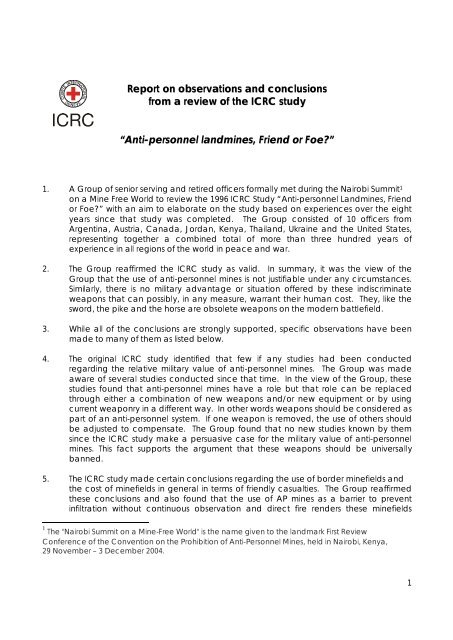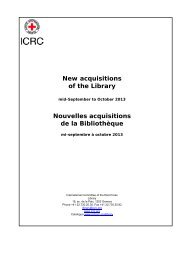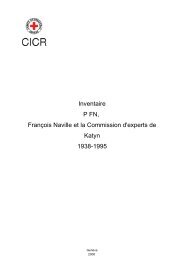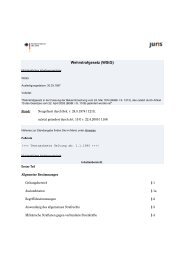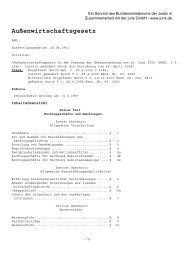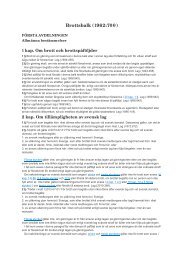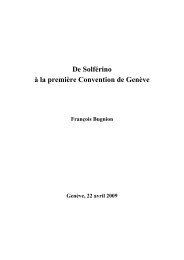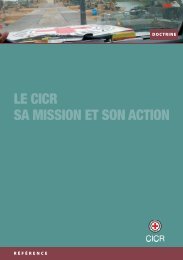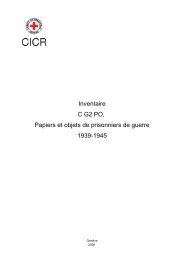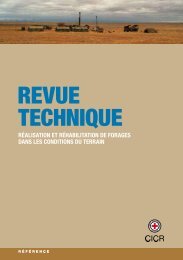Anti-personnel landmines, Friend or Foe? - ICRC
Anti-personnel landmines, Friend or Foe? - ICRC
Anti-personnel landmines, Friend or Foe? - ICRC
You also want an ePaper? Increase the reach of your titles
YUMPU automatically turns print PDFs into web optimized ePapers that Google loves.
Rep<strong>or</strong>t on observations and conclusions<br />
from a review of the <strong>ICRC</strong> study<br />
“<strong>Anti</strong>-<strong>personnel</strong> <strong>landmines</strong>, <strong>Friend</strong> <strong>or</strong> <strong>Foe</strong>?”<br />
1. A Group of seni<strong>or</strong> serving and retired officers f<strong>or</strong>mally met during the Nairobi Summit 1<br />
on a Mine Free W<strong>or</strong>ld to review the 1996 <strong>ICRC</strong> Study “<strong>Anti</strong>-<strong>personnel</strong> Landmines, <strong>Friend</strong><br />
<strong>or</strong> <strong>Foe</strong>?” with an aim to elab<strong>or</strong>ate on the study based on experiences over the eight<br />
years since that study was completed. The Group consisted of 10 officers from<br />
Argentina, Austria, Canada, J<strong>or</strong>dan, Kenya, Thailand, Ukraine and the United States,<br />
representing together a combined total of m<strong>or</strong>e than three hundred years of<br />
experience in all regions of the w<strong>or</strong>ld in peace and war.<br />
2. The Group reaffirmed the <strong>ICRC</strong> study as valid. In summary, it was the view of the<br />
Group that the use of anti-<strong>personnel</strong> mines is not justifiable under any circumstances.<br />
Similarly, there is no military advantage <strong>or</strong> situation offered by these indiscriminate<br />
weapons that can possibly, in any measure, warrant their human cost. They, like the<br />
sw<strong>or</strong>d, the pike and the h<strong>or</strong>se are obsolete weapons on the modern battlefield.<br />
3. While all of the conclusions are strongly supp<strong>or</strong>ted, specific observations have been<br />
made to many of them as listed below.<br />
4. The <strong>or</strong>iginal <strong>ICRC</strong> study identified that few if any studies had been conducted<br />
regarding the relative military value of anti-<strong>personnel</strong> mines. The Group was made<br />
aware of several studies conducted since that time. In the view of the Group, these<br />
studies found that anti-<strong>personnel</strong> mines have a role but that role can be replaced<br />
through either a combination of new weapons and/<strong>or</strong> new equipment <strong>or</strong> by using<br />
current weaponry in a different way. In other w<strong>or</strong>ds weapons should be considered as<br />
part of an anti-<strong>personnel</strong> system. If one weapon is removed, the use of others should<br />
be adjusted to compensate. The Group found that no new studies known by them<br />
since the <strong>ICRC</strong> study make a persuasive case f<strong>or</strong> the military value of anti-<strong>personnel</strong><br />
mines. This fact supp<strong>or</strong>ts the argument that these weapons should be universally<br />
banned.<br />
5. The <strong>ICRC</strong> study made certain conclusions regarding the use of b<strong>or</strong>der minefields and<br />
the cost of minefields in general in terms of friendly casualties. The Group reaffirmed<br />
these conclusions and also found that the use of AP mines as a barrier to prevent<br />
infiltration without continuous observation and direct fire renders these minefields<br />
1 The "Nairobi Summit on a Mine-Free W<strong>or</strong>ld" is the name given to the landmark First Review<br />
Conference of the Convention on the Prohibition of <strong>Anti</strong>-Personnel Mines, held in Nairobi, Kenya,<br />
29 November – 3 December 2004.<br />
1
ineffective. Their use under these conditions on unprotected b<strong>or</strong>ders offers little if any<br />
military value. The Group also found that these minefields lend a false sense of<br />
security, since they will not prevent infiltration. Additionally it has been found that<br />
these unmanned mined areas may often be the preferred routes of infiltration.<br />
6. Casualties are often caused to friendly f<strong>or</strong>ces as a result of the requirement to<br />
maintain their minefields. This was evident in J<strong>or</strong>dan, which, pri<strong>or</strong> to joining the<br />
Convention experienced a significant number of casualties from the maintenance of<br />
their own minefields.<br />
7. Regarding the conclusion from the <strong>ICRC</strong> study on the value of anti-<strong>personnel</strong> mines to<br />
protect anti-tank mines and their value f<strong>or</strong> harassment, the Group found that Military<br />
technology in use f<strong>or</strong> decades renders AP mines obsolete. M<strong>or</strong>e effective methods<br />
such as anti-lift devices to protect anti-tank mines (often called anti-vehicle mines) are<br />
in common use. The Group is also of the opinion that the use of these anti-<strong>personnel</strong><br />
mines f<strong>or</strong> harassment constitutes an illegal use of this weapon and is incompatible with<br />
International Humanitarian Law (Protocol 1, 1977, Additional to the Geneva<br />
Conventions, Article 51).<br />
8. The <strong>ICRC</strong> Study drew several conclusions with regard to remotely delivered mines.<br />
The Group agreed with those conclusions. In some circumstances, remotely delivered<br />
AP mines can pose an even greater threat to civilians than hand emplaced mines.<br />
Additionally they can significantly impede movement of friendly f<strong>or</strong>ces. In the 1991<br />
Gulf War, use of remotely delivered mines by coalition f<strong>or</strong>ces caused those same<br />
f<strong>or</strong>ces to exercise extreme caution in movement. In fact there is evidence that <strong>or</strong>ders<br />
were issued to coalition f<strong>or</strong>ces to avoid areas previously struck from the air because<br />
remotely delivered mines had been dispersed on airfields, supply routes, approaches,<br />
bridges and assembly areas. This s<strong>or</strong>t of directive indicates a lack of inf<strong>or</strong>mation as to<br />
the exact location of “friendly” minefields; and given the types of areas targeted,<br />
manoeuvre of friendly f<strong>or</strong>ces was seriously restricted.<br />
9. Concerning the issue of alternatives to anti-<strong>personnel</strong> mines, the Group agreed with<br />
the conclusion of the study. M<strong>or</strong>eover, we believe that of the current 144 States<br />
Parties to the Convention, none is known to have assigned a high pri<strong>or</strong>ity to the issue of<br />
the development of alternatives, material <strong>or</strong> non-material. This confirms the fact that<br />
such alternatives are no longer considered necessary.<br />
10. Basic improvements in military weapons and equipment ranging from m<strong>or</strong>e and better<br />
automatic weapons through a greater use of protected vehicles to basic sens<strong>or</strong> suites<br />
have rendered anti-<strong>personnel</strong> mines redundant. The technology fielded by most<br />
armies since the mid-seventies has largely “replaced” the limited value offered by anti<strong>personnel</strong><br />
mines.<br />
11. In regard to the need to improve mine clearance technology f<strong>or</strong> humanitarian<br />
demining, the Group recognized that some progress has been made in improving<br />
mine clearance technology and strongly encourages further development of mine<br />
clearance equipment. It was also noted that some mines in stockpiles are very difficult<br />
to destroy safely. In Ukraine and Belarus only, there are m<strong>or</strong>e than 9.5 million PFM<br />
mines in stock awaiting destruction. Technology to solve this problem should be<br />
addressed as a matter of pri<strong>or</strong>ity.<br />
2
12. The final and overarching conclusion of the <strong>ICRC</strong> Study was that “The limited military<br />
utility of AP mines is far outweighed by the appalling humanitarian consequences of<br />
their use in actual conflicts”. The Group strongly believes the h<strong>or</strong>rific impact on the<br />
innocent civilian population far outweighs the marginal and limited military value anti<strong>personnel</strong><br />
mines may have in limited situations.<br />
Unanimously end<strong>or</strong>sed in their personal capacity by the following Group of Seni<strong>or</strong> Military<br />
Officers, 30 November – 1 December 2004;<br />
General (Retd) Zabala<br />
General (Retd) Greindl<br />
General (Retd) Baril<br />
Lieutenant-Colonel (Retd) MacBride<br />
Brigadier-General Al-Maiteh Faleh<br />
Brigadier Tonui<br />
Maj<strong>or</strong>-General Tumrongsak Deemongko<br />
Lieutenant-General (Retd) Tereschenko<br />
Lieutenant-Colonel (Retd) Shved<br />
Lieutenant- General (Retd) Gard<br />
Argentina<br />
Austria<br />
Canada<br />
Canada<br />
J<strong>or</strong>dan<br />
Kenya<br />
Thailand<br />
Ukraine<br />
Ukraine<br />
United States of America<br />
+++<br />
Name's file : ENGLISH<strong>Friend</strong><strong>Foe</strong>Rep<strong>or</strong>tObservations30Nov1Dec2004.doc<br />
June 2005<br />
3


